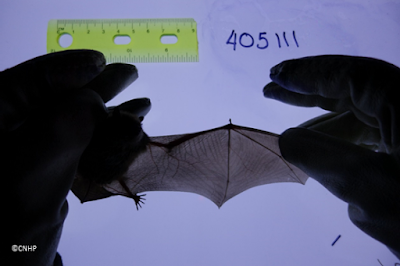By Blaise Newman, CNHP Siegele Intern
Little brown bats (Myotis lucifugus) are widespread across North America. They vary in color from reddish, brown, to golden with a wingspan of 8 to 11 inches and an average weight of less than half an ounce. In the summer, female little brown bats aggregate at sites called maternity roosts which can be found in buildings, caves, and other covered areas.
Unfortunately, the little brown bat is under attack across its range. White nose syndrome (WNS) is a fungus that disturbs the bat’s hibernation pattern wasting valuable energy needed to survive the winter. In eastern North America, the disease has killed millions of bats. The disease has yet to be detected in Colorado, but a recent detection in Washington state has scientists concerned. The Colorado Natural Heritage Program and Colorado Parks and Wildlife have started an ambitious project to monitor little brown bat maternity colonies in the Yampa Valley of Colorado. Obtaining baseline of data of bat survival and persistence prior to WNS is extremely valuable.
At two maternity sites, Jeremy Siemers and Rob Schorr are using passive integrated transponder (PIT) tags to monitor the adult female and juvenile bats. PIT tags are similar to radio-frequency identification (RFID) chips in your pets. PIT tags are unique identifiers that can help estimate mortality, understand behavior, and track population changes over time. However, one major concern for this marking technique is tag loss. For this reason, new methods of individual identification are being explored to work in conjunction with the PIT tags.
Wing venation is a promising identification tool. Similar to a fingerprint, wing venation is thought to be unique to each individual bat. After the bats were captured and tagged, I spread the wings of captured bats over a light board to show the distinct venation patterns. I then used a mounted camera to document the bat wing venation to be analyzed and cataloged later. Hopefully, future studies will be able to identify individual bats using both PIT tag and wing venation IDs.
 |
| Blaise Newman, CNHP Siegele Intern, photographs a little brown bat’s wing venation pattern. This technique is fairly new, and holds promise as a way to identify individual bats. |




